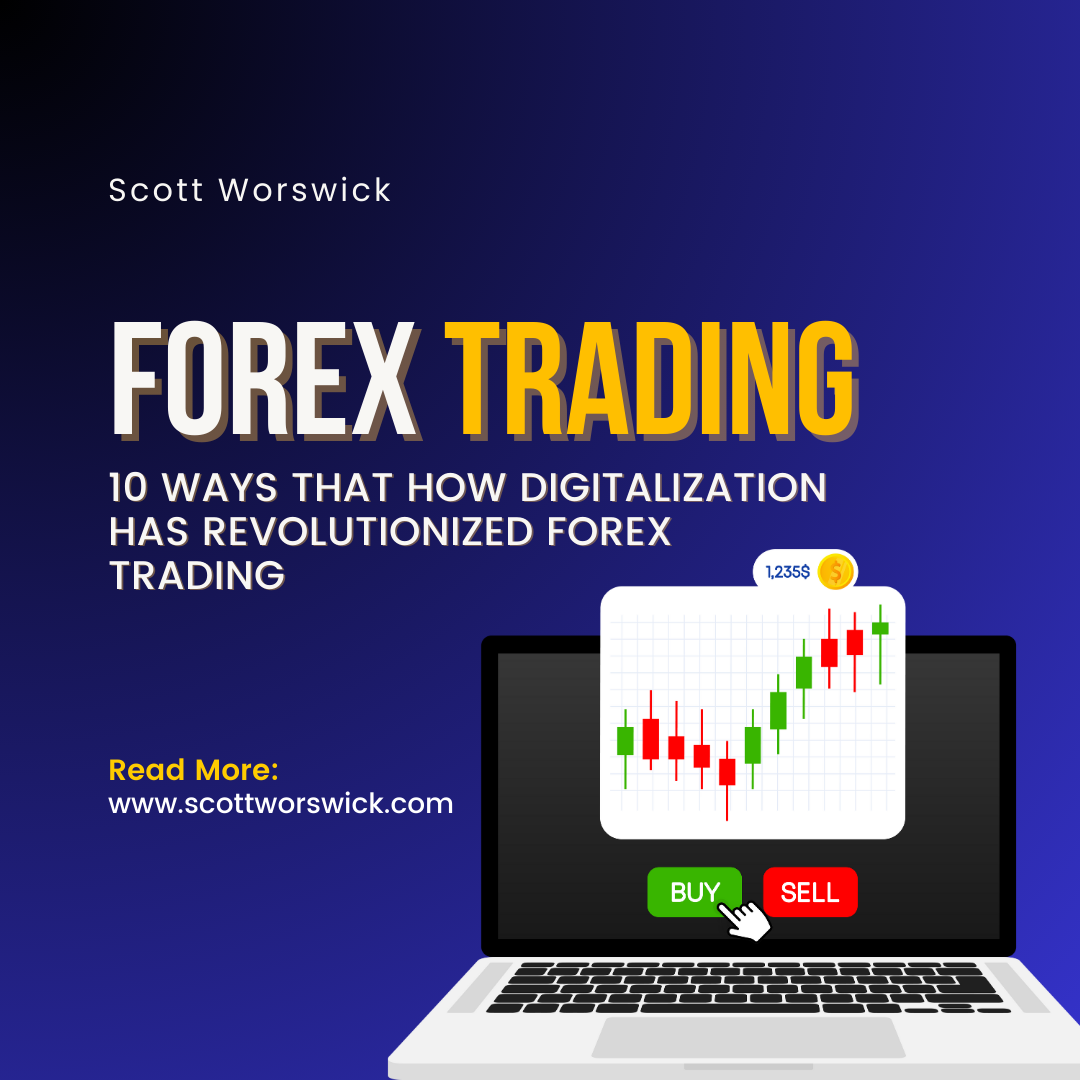In the vast arena of financial markets, perhaps no sector has been as profoundly impacted by the relentless march of digitalization as forex trading. The fusion of cutting-edge technology with the complexities of global currency exchange has sparked a revolution, transforming the way traders interact with the foreign exchange market. Gone are the days of crowded trading floors and frantic phone calls; today, it unfolds in the virtual realm, where algorithms execute trades at the speed of light and real-time data streams illuminate market movements with unparalleled clarity.
At the heart of this transformation lies the democratization of access to forex trading. Once the exclusive domain of financial institutions and seasoned professionals, the advent of digitalization has dismantled barriers to entry, inviting individuals from all walks of life to participate in the world’s largest financial market. Armed with nothing more than a computer or smartphone and an internet connection, aspiring traders can now embark on their trading journey, empowered by a wealth of resources and tools previously unimaginable.
However, the impact of digitalization extends far beyond mere accessibility. It has ushered in an era of unprecedented connectivity, where traders from every corner of the globe converge in a virtual marketplace that operates around the clock. With a few clicks, traders can tap into vast pools of liquidity, execute transactions seamlessly, and navigate the intricacies of the forex market with ease. Moreover, digitalization has paved the way for innovation, giving rise to sophisticated analytical platforms, automated trading algorithms, and social trading networks that redefine the boundaries of possibility in trading.
Table of Contents
1. Accessibility Redefined
In the evolution of forex trading, one of the most striking changes brought about by digitalization is the redefinition of accessibility. Once confined to the realm of institutional investors and financial elites, the forex market is now within reach of anyone with an internet connection and a desire to participate. Digitalization has dismantled the traditional barriers to entry, democratizing access and leveling the playing field for individuals worldwide. Whether you’re a seasoned trader or a newcomer to the financial markets, the opportunity to engage in this stuff has never been more accessible or inclusive.
Digital platforms have become the gateway to the world of forex trading, offering intuitive interfaces and user-friendly tools that streamline the process of buying and selling currencies. From desktop computers to mobile devices, traders can now access the forex market anytime, anywhere, allowing for unprecedented flexibility and convenience. This newfound accessibility has empowered individuals to take control of their financial futures, bypassing the need for intermediaries and putting the power of trading directly into their hands.
Moreover, the rise of online brokerages and trading platforms has further expanded access to this thing, offering a wide range of account options and educational resources tailored to traders of all experience levels. Whether you’re a beginner seeking to learn the basics of it or an experienced investor looking to refine your strategies, there are countless resources available at your fingertips. This wealth of information not only helps traders navigate the complexities of the forex market but also fosters a culture of continuous learning and improvement.
In essence, digitalization has democratized it, transforming it from an exclusive club reserved for the privileged few into a vibrant marketplace accessible to all. By breaking down barriers and harnessing the power of technology, digitalization has opened doors to new opportunities, enabling individuals from diverse backgrounds to participate in the global economy and chart their own paths to financial success.
2. Real-Time Data and Analysis
In the dynamic world of forex trading, the advent of digitalization has ushered in an era of unparalleled access to real-time data and sophisticated analysis tools. Gone are the days of relying on outdated market reports and delayed information; today’s traders have instant access to a wealth of data streams that provide up-to-the-second insights into currency movements and market trends. This real-time data empowers traders to make informed decisions with precision and agility, seizing opportunities as they arise and navigating the complexities of the forex market with confidence.
Digitalization has revolutionized the way traders analyze and interpret market data, providing access to advanced charting tools and analytical platforms that were once reserved for institutional investors. From customizable charts and technical indicators to algorithmic trading algorithms, these tools enable traders to conduct in-depth analysis and identify potential trading opportunities with greater accuracy and efficiency. Whether you’re a day trader looking to capitalize on short-term fluctuations or a long-term investor seeking to identify macroeconomic trends, digitalization has leveled the playing field, giving traders of all stripes the tools they need to succeed in the forex market.
Moreover, the integration of artificial intelligence and machine learning algorithms has taken real-time analysis to new heights, allowing traders to leverage predictive analytics and pattern recognition to gain a competitive edge. These AI-powered tools can sift through vast amounts of data, identify emerging patterns, and generate actionable insights in real-time, enabling traders to stay ahead of the curve and adapt to changing market conditions with ease. In essence, digitalization has transformed forex trading from a game of chance into a data-driven science, where success hinges on the ability to harness the power of technology to uncover hidden opportunities and make informed decisions in the blink of an eye.
3. Automation and Algorithmic Forex Trading
Digitalization has revolutionized forex trading through the advent of automation and algorithmic trading, marking a seismic shift in how trades are executed and strategies are implemented. Gone are the days of manual order placement and emotional decision-making; today, traders harness the power of algorithms to execute trades with precision and efficiency. Automation has not only streamlined the trading process but also minimized human error, allowing traders to execute their strategies with discipline and consistency.
Algorithmic forex trading algorithms are the cornerstone of this transformation, employing complex mathematical models and statistical analysis to identify trading opportunities and execute orders automatically. These algorithms can analyze vast amounts of market data in real-time, identifying patterns and trends that may elude human traders. By removing the emotional element from trading decisions, algorithmic trading algorithms help traders avoid common pitfalls such as fear, greed, and impulse, leading to more rational and objective decision-making.
Moreover, automation has democratized access to it, making it accessible to traders of all experience levels. Whether you’re a novice trader learning the ropes or a seasoned investor with years of experience, algorithmic trading algorithms offer a level playing field, allowing traders to compete on the basis of strategy and execution rather than size or resources. In essence, automation and algorithmic trading have transformed it from an art into a science, where success is determined not by gut instinct or intuition but by the ability to harness the power of technology to analyze data, execute trades, and manage risk with precision and efficiency.
4. Global Connectivity
In the realm of forex trading, digitalization has catalyzed a paradigm shift by fostering unprecedented levels of global connectivity. No longer bound by geographical constraints, traders from every corner of the globe now converge in a virtual marketplace that operates around the clock. This seamless connectivity has transformed it into a truly global endeavor, where liquidity flows freely and opportunities abound regardless of time zone or location. Whether you’re in Tokyo, London, or New York, the forex market is always just a click away, offering a level of accessibility and opportunity that was once unimaginable.
The rise of digital platforms and online brokerages has been instrumental in facilitating this global connectivity, providing traders with instant access to a vast network of counterparties and liquidity providers. With a few keystrokes, traders can tap into a diverse range of currency pairs and execute trades at lightning speed, capitalizing on market movements in real-time. Moreover, digitalization has enabled seamless cross-border transactions, allowing traders to navigate the complexities of the global forex market with ease and efficiency.
Furthermore, digitalization has fostered collaboration and knowledge-sharing on a global scale, with traders leveraging social media, forums, and online communities to exchange insights, strategies, and market intelligence in real-time. This interconnected ecosystem not only enhances transparency and liquidity but also cultivates a sense of camaraderie and community among traders worldwide. In essence, global connectivity lies at the heart of the digital revolution in forex trading, empowering traders to transcend borders and seize opportunities in a borderless marketplace driven by innovation and technology.
5. Enhanced Security Measures
In the landscape of forex trading, digitalization has ushered in a new era of enhanced security measures, safeguarding traders’ funds and personal information against an ever-evolving array of cyber threats. With the proliferation of online trading platforms and the rise of digital transactions, ensuring the security and integrity of trading has become paramount. Digitalization has led to the implementation of robust security protocols, encryption technologies, and multi-factor authentication methods, providing traders with peace of mind and confidence in the safety of their assets.
Moreover, regulatory authorities around the world have stepped up efforts to combat fraud and ensure compliance with stringent security standards in the forex trading industry. From stringent KYC (Know Your Customer) procedures to anti-money laundering (AML) regulations, regulatory frameworks have been strengthened to protect traders from illicit activities and ensure the integrity of the financial system. Digitalization has enabled greater transparency and accountability, allowing regulatory authorities to monitor and enforce compliance more effectively, thereby bolstering trust and confidence in its ecosystem.
Furthermore, the advent of blockchain technology has introduced innovative solutions to enhance security and transparency in forex trading. By leveraging decentralized ledgers and cryptographic algorithms, blockchain-based platforms offer immutable records of transactions, providing an additional layer of security against tampering and fraud. The adoption of blockchain technology in this does not only enhances security but also streamlines processes, reduces costs, and mitigates counterparty risk, further solidifying the foundation of trust upon which the digitalized its landscape is built.
6. Mobile Trading Apps
Digitalization has revolutionized forex trading by placing the power of the market directly into the palm of traders’ hands through mobile trading apps. Gone are the days when traders were tethered to their desks; now, they can execute trades, monitor market movements, and manage their portfolios anytime, anywhere, with the convenience of a smartphone or tablet. These mobile trading apps offer intuitive interfaces, real-time data feeds, and advanced charting tools, allowing traders to stay connected to the forex market even while on the go.
The proliferation of mobile trading apps has democratized access to forex trading, empowering individuals from all walks of life to participate in the global currency exchange market. Whether you’re a seasoned trader executing complex strategies or a novice investor dipping your toes into it for the first time, mobile apps provide a user-friendly gateway to the world of forex trading. With just a few taps, traders can access a wide range of currency pairs, place trades, set alerts, and manage their positions with ease, making it more accessible and inclusive than ever before.
Moreover, mobile trading apps offer a level of flexibility and freedom that was once unimaginable in the world of forex trading. Whether you’re commuting to work, waiting in line, or relaxing at home, you can keep a pulse on the forex market and seize opportunities as they arise, without being confined to a desktop computer. This seamless integration of this stuff into everyday life not only enhances convenience but also empowers traders to take control of their financial futures on their own terms, ushering in a new era of accessibility and empowerment in the digitalized its landscape.
7. Educational Resources
Digitalization has ushered in a wealth of educational resources that have revolutionized forex trading, providing traders with unprecedented access to learning materials, tutorials, webinars, and demo accounts. Gone are the days when aspiring traders had to rely solely on textbooks and expensive seminars to learn the intricacies of this future blossom thing. Today, a plethora of online resources are readily available at the fingertips of traders, offering comprehensive insights into market dynamics, trading strategies, risk management techniques, and more.
These educational resources cater to traders of all experience levels, from beginners seeking to grasp the fundamentals of it to seasoned professionals looking to refine their strategies and stay abreast of the latest market trends. Whether you prefer video tutorials, interactive quizzes, or live webinars hosted by industry experts, there is a vast array of educational content tailored to suit your learning style and pace. Furthermore, many online brokerages and trading platforms offer free demo accounts that allow traders to practice their skills in a risk-free environment, honing their strategies and gaining valuable hands-on experience before diving into live forex trading.
Moreover, the digitalization of forex trading has fostered a culture of continuous learning and improvement, with online communities, forums, and social media platforms serving as hubs for knowledge-sharing and collaboration among traders worldwide. Whether you’re seeking advice, sharing insights, or engaging in lively discussions about market trends, these online communities provide a supportive and interactive environment where traders can learn from each other’s experiences and perspectives. This interconnected ecosystem not only enhances the learning experience but also fosters a sense of camaraderie and community among traders, enriching the forex trading landscape in profound ways.
In essence, the digitalization of trading has democratized access to educational resources, empowering traders to take control of their financial futures and pursue their trading goals with confidence and competence. By providing a wealth of learning materials, interactive tools, and collaborative platforms, digitalization has transformed it from a daunting endeavor into an accessible and rewarding journey of discovery and growth.
8. Social Trading Networks
Digitalization has brought about a seismic shift in the landscape of forex trading, and at the forefront of this transformation are social trading networks. These platforms have revolutionized the way traders interact, collaborate, and share insights within the forex community. By leveraging the power of social media and online networking, social trading networks provide traders with a dynamic environment where they can connect with peers, follow experienced traders, and replicate their strategies in real-time. This social aspect of this thing not only fosters a sense of camaraderie and community but also opens up new avenues for learning and collaboration.
One of the key features of social trading networks is the ability to observe and learn from successful traders in real-time. By following and emulating the trades of top performers, novice traders can gain valuable insights into effective trading strategies, risk management techniques, and market dynamics. This hands-on learning experience allows traders to accelerate their learning curve and improve their trading skills through practical observation and application.
Moreover, social trading networks offer a platform for traders to share their own insights, strategies, and performance metrics with the community. By contributing to the collective knowledge pool, traders can engage in meaningful discussions, exchange ideas, and receive feedback from their peers. This collaborative approach to forex trading not only enhances transparency and accountability but also fosters innovation and idea generation within the community.
Furthermore, social trading networks provide traders with valuable tools and features to facilitate communication and interaction, such as chat rooms, forums, and live streaming. These platforms create a dynamic and interactive environment where traders can engage in real-time discussions, share breaking news, and analyze market trends together. By harnessing the collective wisdom of the crowd, social trading networks empower traders to make more informed decisions and navigate the complexities of forex trading with confidence and clarity.
9. Regulatory Transparency
Digitalization has significantly enhanced regulatory transparency within the realm of forex trading, marking a pivotal shift towards greater accountability and integrity in the financial markets. As its landscape evolves in the digital age, regulatory authorities around the world have implemented stringent guidelines and reporting requirements to ensure fair and transparent trading practices. These regulations are aimed at safeguarding the interests of traders, mitigating systemic risks, and maintaining the integrity of the forex market.
One of the key benefits of digitalization is the increased transparency it brings to forex trading, enabling regulatory authorities to monitor and enforce compliance more effectively. With the advent of digital platforms and online trading, regulators have access to a wealth of data and transaction records, allowing them to detect and deter fraudulent activities, market manipulation, and other forms of misconduct. This heightened level of transparency not only protects traders from potential abuses but also fosters trust and confidence in the forex market as a whole.
Moreover, digitalization has facilitated greater collaboration and information-sharing among regulatory authorities, leading to more harmonized regulatory frameworks and standards across different jurisdictions. By working together to address common challenges and share best practices, regulators can create a more cohesive and resilient regulatory environment that promotes market stability and investor protection. In essence, regulatory transparency is a cornerstone of the digital revolution in trading, laying the foundation for a more secure, transparent, and trustworthy marketplace where traders can operate with confidence and peace of mind.
10. Innovation and Evolution
Innovation and evolution are the driving forces behind the digital revolution in forex trading, propelling the industry into new frontiers of efficiency, accessibility, and sophistication. With the rapid pace of technological advancement, it has undergone a remarkable transformation, with new tools, techniques, and strategies constantly emerging to meet the evolving needs of traders in the digital age. From artificial intelligence and machine learning algorithms to blockchain technology and cryptocurrency integration, the possibilities for innovation in trading are virtually limitless, promising to reshape the future of the industry in profound ways.
One of the most notable innovations in forex trading is the integration of artificial intelligence and machine learning algorithms, which have revolutionized the way traders analyze data, identify patterns, and execute trades. These advanced algorithms can sift through vast amounts of market data in real-time, identifying trends, correlations, and anomalies that may elude human traders. By harnessing the power of AI, traders can gain valuable insights into market dynamics, make more informed trading decisions, and adapt to changing market conditions with agility and precision.
Furthermore, its digitalization has spurred a culture of continuous innovation and experimentation, with traders and technologists alike pushing the boundaries of what is possible in the world of finance. From algorithmic trading strategies and high-frequency trading systems to innovative financial products and trading platforms, the landscape of trading is constantly evolving in response to technological advancements and market trends. In essence, innovation and evolution are the driving forces behind the digital revolution in it, fueling a cycle of creativity, adaptation, and progress that promises to reshape the industry for years to come.
Conclusion
In conclusion, the digitalization of forex trading has ushered in a new era of unprecedented opportunity, accessibility, and innovation, transforming the way traders engage with the global currency markets. From the democratization of access and the proliferation of real-time data to the integration of automation and the emergence of social trading networks, digitalization has revolutionized every aspect of its landscape. No longer bound by geographical constraints or institutional barriers, individuals from all walks of life can now participate in it with ease, empowered by a wealth of resources and tools at their fingertips.
Moreover, digitalization has fostered a culture of continuous learning and collaboration within its community, where traders can connect, share insights, and learn from one another in real-time. Through social trading networks, online forums, and educational resources, traders can access a wealth of knowledge and expertise, accelerating their learning curve and honing their skills in the dynamic world of it. This interconnected ecosystem not only enhances transparency and accountability but also cultivates a sense of camaraderie and community among traders worldwide.
Looking ahead, the future of forex trading holds boundless opportunities for further innovation and evolution as technology continues to advance and market dynamics evolve. Whether it’s the integration of artificial intelligence, the proliferation of blockchain technology, or the emergence of new financial instruments and trading platforms, the digital revolution in forex trading shows no signs of slowing down. In essence, digitalization has not only revolutionized forex trading but has also democratized access, fostered collaboration, and paved the way for a more inclusive and dynamic marketplace where traders can thrive in the digital age.







Pingback: The Advantages of Forex Trading for Individuals in the Digital Age -
Pingback: Forex Trading: A Pathway to Financial Independence -